Dear Reader, in this age of AI created content, please support with your goodwill someone who works harder to provide the human-made. Sign up at the top of the lefthand column or bottom of this page. You will receive my hand illustrated monthly newsletter RESTORE NATURE and access to the biodiversity garden design course as I write...and nothing else, I respect your time. I am also removing the advertizing as best I can as its become intrusive inappropriate and pays me nothing.
Asteraceae design
spring flowers
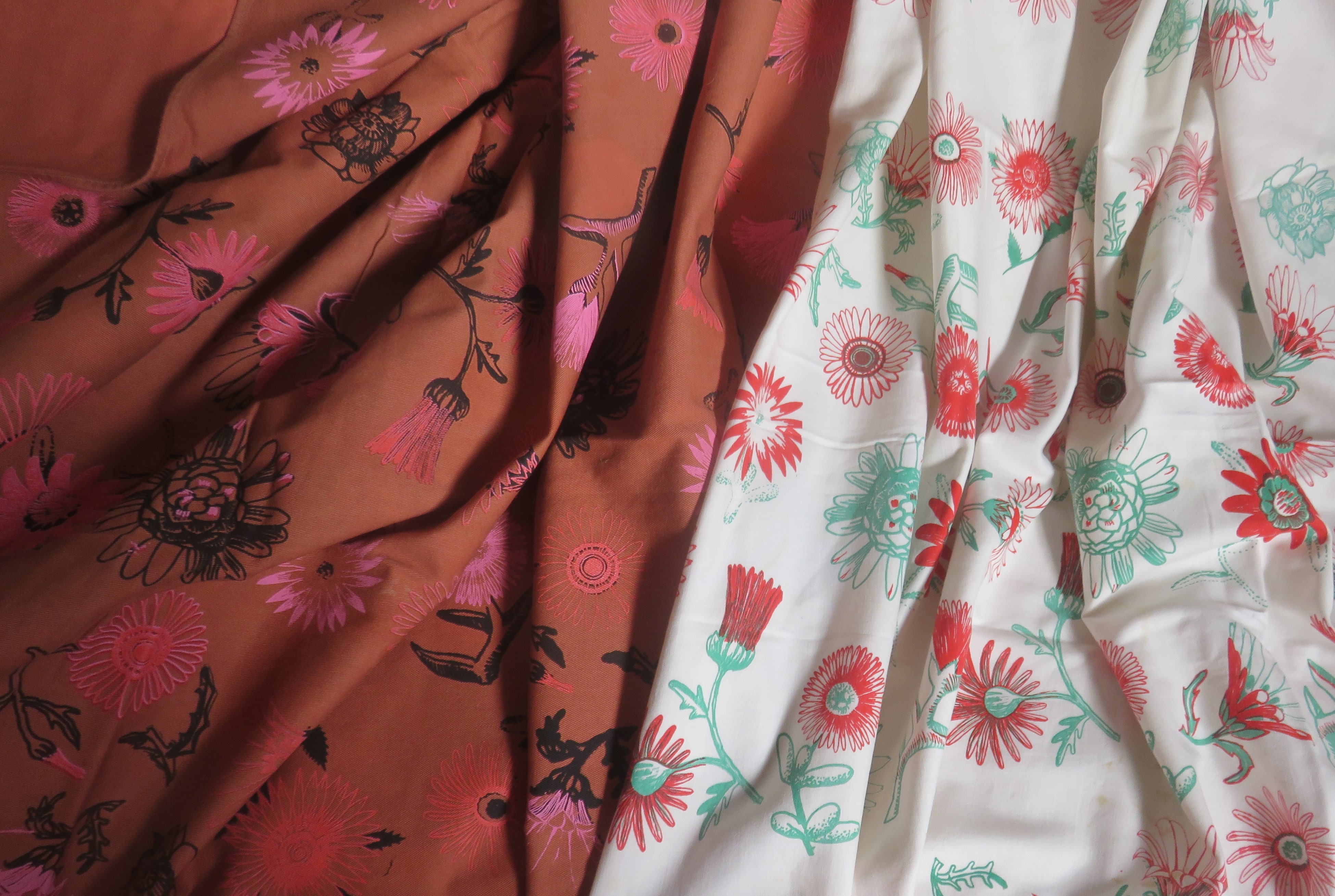 screen printed cloth
screen printed clothThe primal beauty of
spring flowers
I made this simple design of Asteraceae, or indigenous plants in the daisy family from South Africa to try and recreate the feeling of spring time on fabric.
In our spring, from about September to November, the dry summer coastal areas of the Western Cape of South Africa burst into bloom. As one walks through the fields of fleeting green, the surface beneath one's feet is like a heaven of bright differently colored stars, or a rich and beautiful Iranian carpet. Actually, there are no words to describe the feeling it gives, and no art which does anything more than suggest this beauty.
Seeing those flowers excites something deep in my animal brain. It is like a door opening into a long long vision of time, a view of future and past generations. I become acutely aware that this is one spring, among millions, and I am just enjoying the flowers with all my senses, like a beetle or a butterfly would, I feel small but deeply happy.
If modern human beings originate in the Cape or spent so many millennia here, this response may be hard wired, and I'm not alone in my instinctive reaction. In the fields of flowers, I'm overwhelmed both by a mild religious ecstasy, and romantic feelings. Perhaps our ancestors in deep time reacted similarly to the flowers of spring.
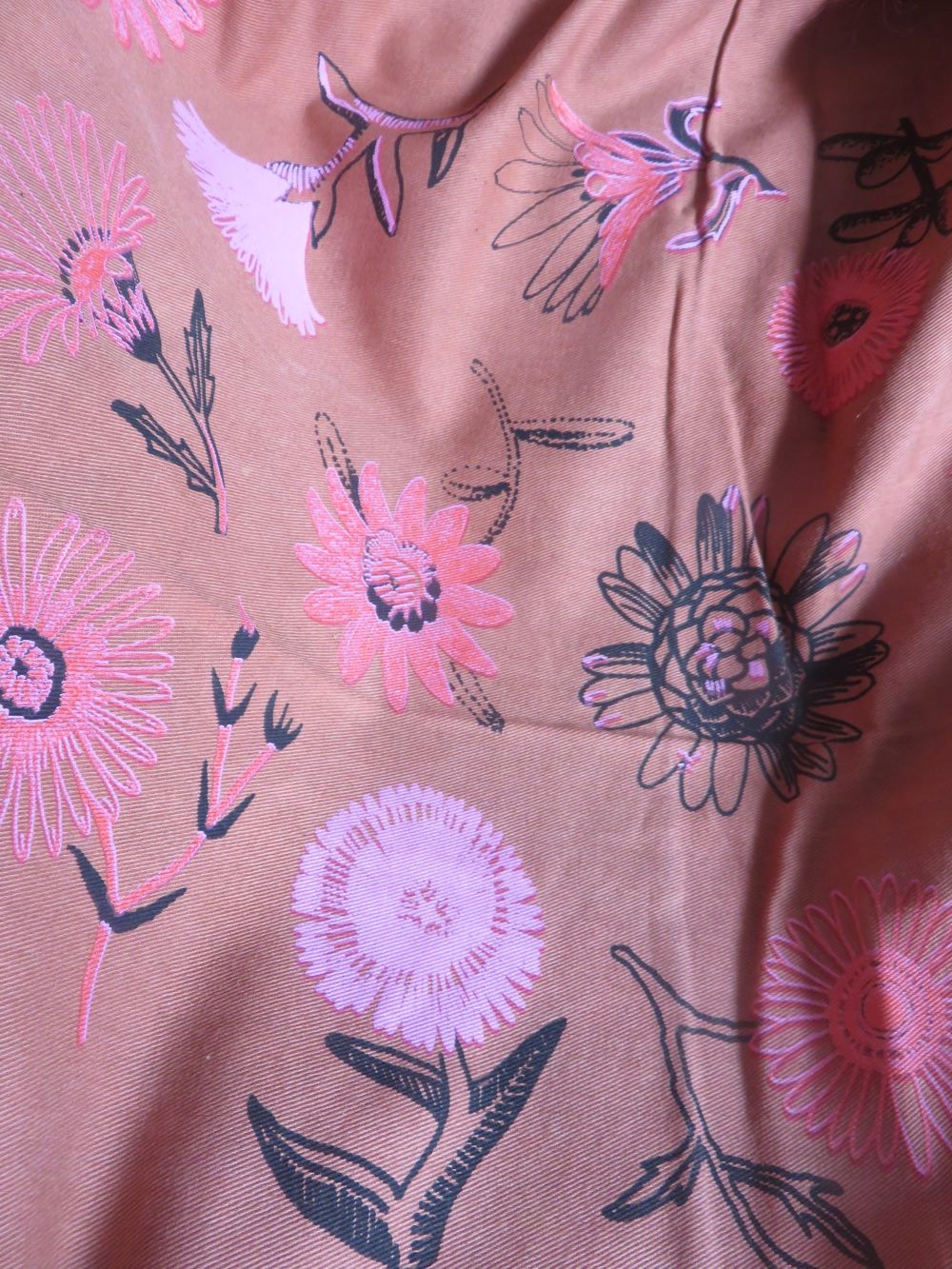 hand dyed red ochre hand dyed red ochre |
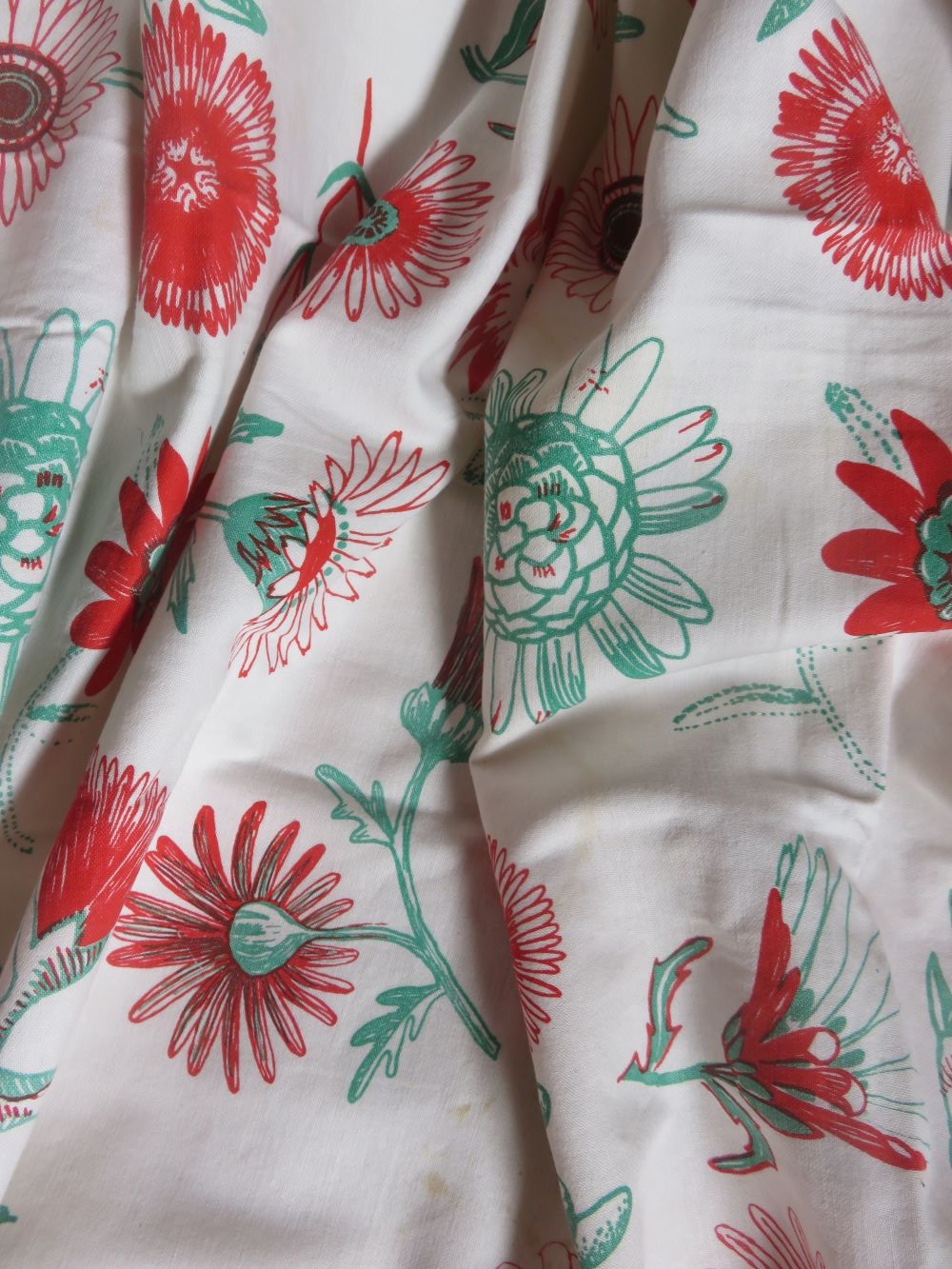 unbleached twill unbleached twill |
The visual display of diversity
In this fleeting spring display, in areas which have been protected, the seasonal vleis, or shallow wetlands, which dry up in the heat of summer, are full of flowers. The insects and plants make the most of this window of reproductive ease. Geissorhiza radians, the jewel in the Cape's floral crown, a deep purple and red that are unnatural in their intensity, floats amid reflected clouds and blue sky in the shallow water. Small orange Gladiolus, dark purple blue Babiana, seas of nodding pink umbrella shaped Monsonia, yellow, or white Spiloxene stars with a peacock centre, the glowing spikes of Kniphofia, and smaller Lachenalia, in many colours, tiny orchids, Albuca's pale green bells, the red glistening Drosera, Ixias gold and pink, a range of Romulea reds, white chinkerenchees, a few late arums, blue flax waving above, sunbursts of Carpobrotus or ice plants, lie at one's feet. Other members of the Asteraceae, like Arctotis, Dimorphotheca, Gazania, and their cousins, cover the ground in sheets of flame red, orange, gold, and white. These are just the plants that make an impression with their numbers, size, or intensity of colour. It is the tip of the floral iceberg.
Choosing Asteraceae to limit the visual diversity for designing
There is such a diversity of flowers of many families and genera, it is impossible to really capture that diversity with a camera or in a design. The flowers embedded in the rich hand dyed wools of old Persia are merely a dull sign of this brighter reality. When designing a spring floral, I also had to reduce the abundance somehow, to something that could be expressed in two dimensions with print colors, and make a rhythmic pattern. I chose to restrict the design to one family, Asteraceae or the daisy family. They are a very diverse group, especially at the Cape, and they have mostly radially symmetrical flowers, which similarity is nice for rhythm in designing. As you will see, there is still a lot of variation in form.

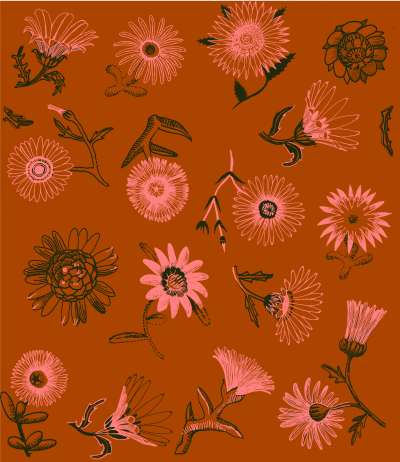

wild flowers in wilder colors
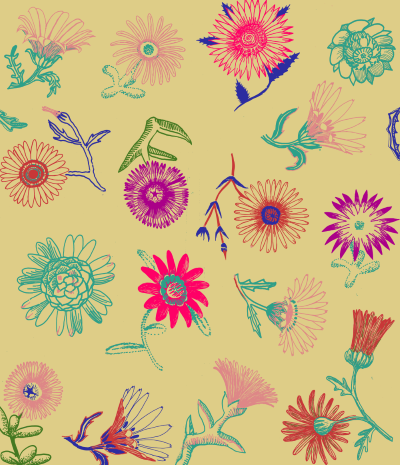

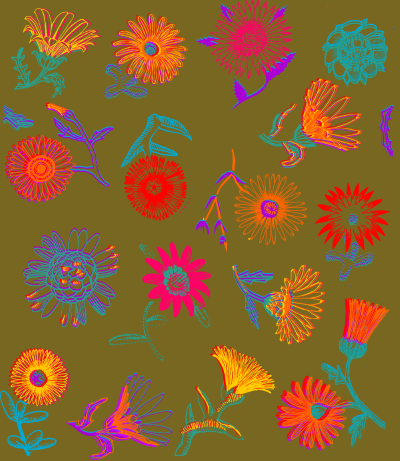
Digitizing the original ink drawings of this Asteraceae design took the color in two directions, one into the more classic colors of natural dyes found in chintz (madder and indigo) and one into intense unnatural colors. For a screen printer, making flat color separations the old fashioned way, rather than using dots (the screen printed version of pixels) from photographs, this progression is just a squeegee stroke away. Screen printing leads to color accidents quite often, and allows this kind of freedom.
I am so familiar with these flowers, these icons of South African botany, having been in Darling every year for decades selling my cloths, that seeing them in wild new colors gives me a thrill of strangeness. I must admit I've fallen in love with some of my accidents during the digitization process. But there is something else. Many local artists love extremely bright color and its been around for many generations. Its possible I like such pure incandescent color because I'm South African. Pushing some of the flowers out of register, so that its like seeing double, just increased the appeal of abstraction and strangeness for me.
Surprisingly, I find that in essence, these intense colors I've given to the Asteraceae, come closer to conveying the hyper real experience of walking in our carpets of spring flowers, than my subdued screen-printed fabrics from long ago.
 |
 |
Restore Nature Newsletter
I've been writing for four years now and I would love to hear from you
Please let me know if you have any questions, comments or stories to share on gardening, permaculture, regenerative agriculture, food forests, natural gardening, do nothing gardening, observations about pests and diseases, foraging, dealing with and using weeds constructively, composting and going offgrid.
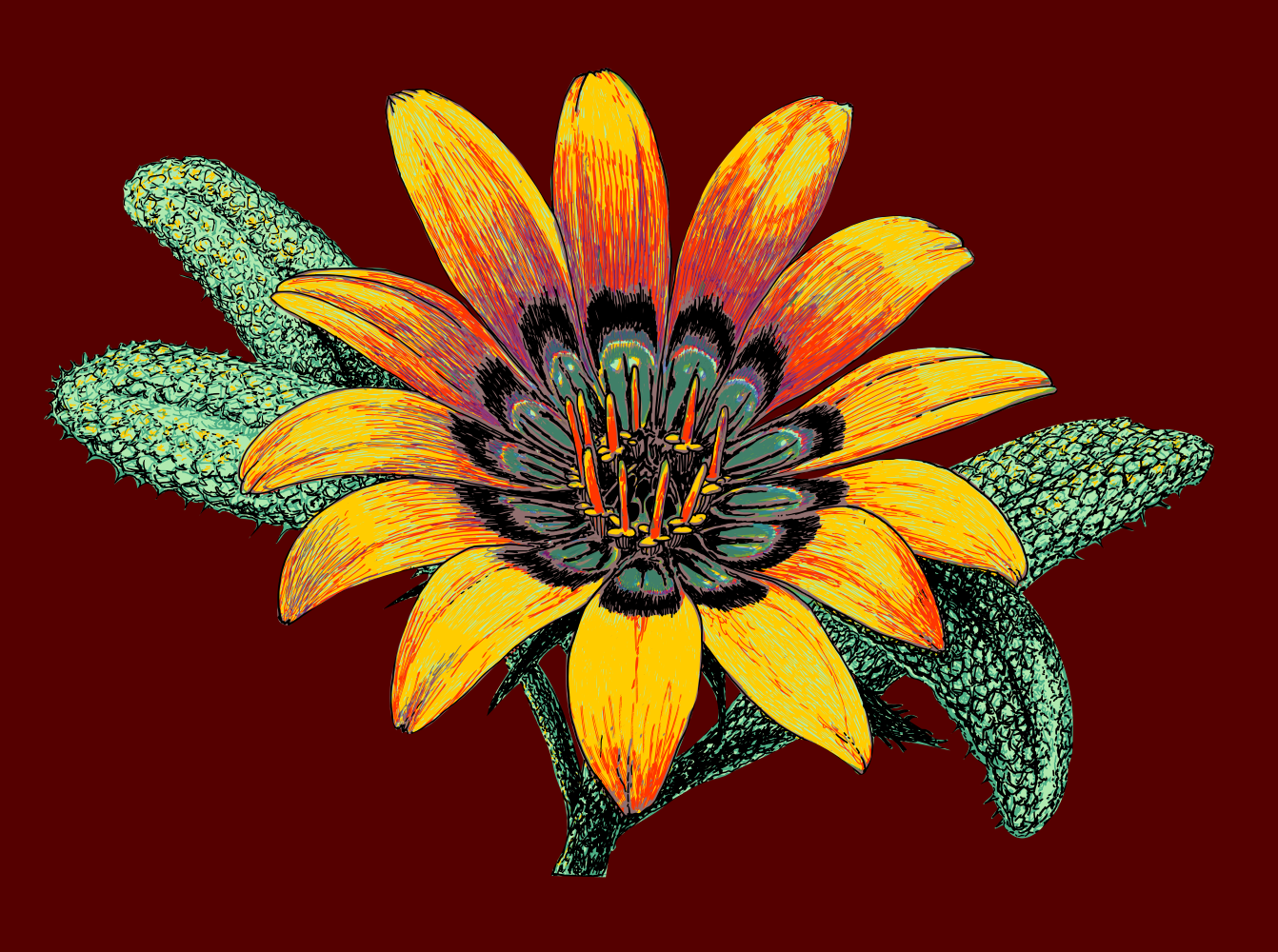 Gorteria diffusa
Gorteria diffusaGorteria diffusa is called beetle daisy in English and Katoog or cat's eye in Afrikaans. G. Diffusa is in the Asteraceae family and shows enormous regional variation in appearance and number of ray florets, with fourteen discreet varieties. Like many South African and especially Cape plants, it was first described by Carl Thunberg, and that in 1798. Since then it has been shuffled around taxanomically by many botanists, perhaps due to the large variety in form that it shows. G. Diffusa is found in South Africa and Namibia, and is endemic to the area between the Orange river and Clanwilliam. The region has cool wet winters and hot dry summers. It is an annual. The seeds, called cypselas, remain attached to the flower heads and can even germinate there. They can germinate one at a time over several years to bridge drought periods. It has a creeping habit and flowers in August and October in our spring. Some varieties showing fly mimicry to attract male flies. It is visited by generalist insects like monkey beetles and honeybees, but also a species specific bee fly Megapalpus capensis. The male Megapalpus being attracted to the raised black markings on some of the bracts, near the flower center, which look like the body of a beetle. Here is a link to the design.
------
home page for links to articles on regeneration, perennial food plants and permaculture
------
Background to our flora and fauna designs
------
SEARCH
Order the Kindle E-book for the SPECIAL PRICE of only
Prices valid till 30.09.2023
Recent Articles
-
garden for life is a blog about saving the earth one garden at a time
Apr 18, 25 01:18 PM
The garden for life blog has short articles on gardening for biodiversity with native plants and regenerating soil for climate amelioration and nutritious food -
Cape Flats Sand Fynbos, Cape Town's most endangered native vegetation!
Apr 18, 25 10:36 AM
Cape Flats Sand Fynbos, a vegetation type found in the super diverse Cape Fynbos region is threatened by Cape Town's urban development and invasive alien plants -
Geography Research Task
Jan 31, 25 11:37 PM
To whom it may concern My name is Tanyaradzwa Madziwa and I am a matric student at Springfield Convent School. As part of our geography syllabus for this
"How to start a profitable worm business on a shoestring budget
Order a printed copy from "Amazon" at the SPECIAL PRICE of only
or a digital version from the "Kindle" store at the SPECIAL PRICE of only
Prices valid till 30.09.2023







